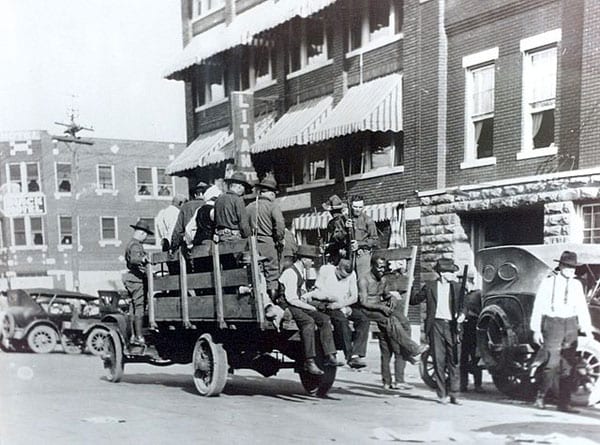
October 11, 2018; Washington Post
Earlier this month, Tulsa Republican mayor, G.T. Bynum, announced that the city would reopen an investigation into whether Black victims of the city’s 1921 massacre, often called the Tulsa Race Riot, were buried in mass graves. “I always thought, if I am ever mayor…that I would do something about it. Because I think if there are mass graves there, the citizens of Tulsa deserve to know, and the victims and their families deserve to know it.”
As DaNeen Brown writes in the Washington Post, “Witnesses to the massacre recalled seeing white mobs looting homes of Black people, pulling out finely carved furniture, pianos, mink and leopard coats, before setting the houses on fire. There were reports that hundreds of bodies were thrown into the Arkansas River or buried in mass graves.”
The Tulsa massacre remains, according to the nonprofit Greenwood Cultural Center in Tulsa, which opened a 25,000-square-foot museum in 1995, “the single deadliest and most destructive act of racial violence and domestic terrorism in United States history.”
As Brown details:
The massacre began on May 31, 1921, when white mobs descended on Greenwood, burning houses and shooting Black people. Some people were burned alive, and 40 square blocks of business and residential property—valued then at more than $1 million—were destroyed.
The rampage, which lasted 48 hours, left more than 10,000 Black residents of Greenwood homeless and as many as 300 Black people dead. The original reported death toll was 36. However, a 2001 commission estimated the death toll to lie between 100 and 300.
Sign up for our free newsletters
Subscribe to NPQ's newsletters to have our top stories delivered directly to your inbox.
By signing up, you agree to our privacy policy and terms of use, and to receive messages from NPQ and our partners.
For decades, however, as A.G. Sultzberger writes in the New York Times, “The Tulsa race riot of 1921 was rarely mentioned in history books, classrooms or even in private. Blacks and whites alike grew into middle age unaware of what had taken place.” It was only in 2012 when the public schools in Tulsa began to teach about the riot in history classes.
The Tulsa riot was the nation’s largest, but it was hardly unique. As Sultzberger explains, “a string of violent riots were started by whites in the years after World War I.” This timing is not coincidental. As Chad Williams, now a Professor of History and African and African American Studies at Brandeis University, writes, during World War I, “Over one million African Americans responded to their draft calls, and roughly 370,000 Black men were inducted into the army.” After the war, “the return of Black soldiers spawned a nationwide surge in violence, much of it directed at African Americans.” Other prominent cities, Williams notes, to have similar white riots after World War I include Chicago and Washington, DC.
Commonly, as was the case in Tulsa, riots would start with an accusation that a Black man had sexually assaulted a white woman. A headline in one paper in Tulsa, was “Nab Negro for Attacking Girl in Elevator.” The same paper ran an editorial disturbingly titled, “To Lynch Negro Tonight.”
What was considered “assault” in 1921 Tulsa? According to Brown, there was an interaction involving Dick Rowland, a 19-year-old Black shoeshiner, and Sarah Page, a white elevator operator, in which the Oklahoma Historical Society indicates that “the most common explanation is that Rowland stepped on Page’s foot as he entered the elevator, causing her to scream.”
Notably, the site of the Tulsa race riots, the Greenwood District, was one of the most prosperous Black communities in the United States at the time, widely known as “Black Wall Street.” Brown explains, “Before the massacre, Greenwood had a population of more than 100,000 Black people, according to the Greenwood Cultural Center’s history of the community. It was home to luxury shops, 21 restaurants, 30 grocery stores, a hospital, a savings and loan, a post office, three hotels, jewelry and clothing stores, two movie theaters, a library, pool halls, a bus and cab service, a nationally recognized school system, six private airplanes, and two Black newspapers.”
The approaching 100th anniversary of the Tulsa riots, which is only two-and-a-half years away, may have helped motivate the mayor’s action to search for mass graves.
“We owe it to the community to know if there are mass graves in our city,” says Bynum. “We owe it to the victims and their family members. We will do everything we can to find out what happened in 1921.”—Steve Dubb













